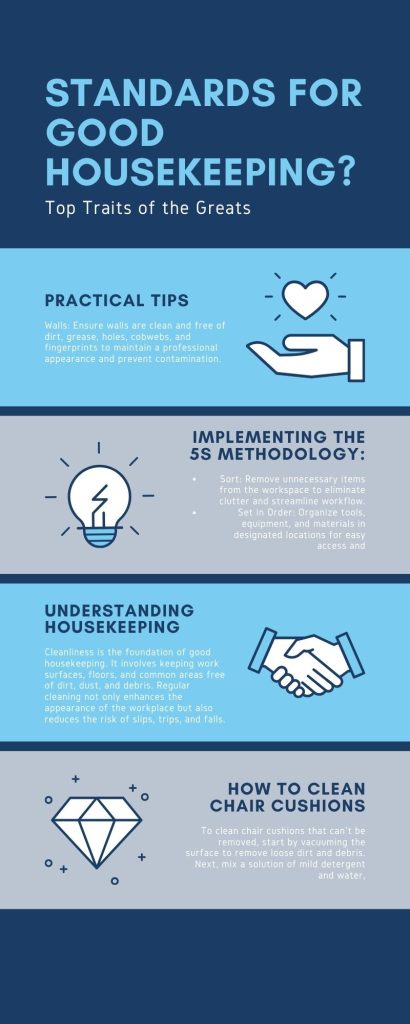Introduction:
Welcome to the ultimate guideWhat are the standards for good housekeeping? Whether you’re a business owner, manager, or employee, understanding the basics of housekeeping is crucial for maintaining a safe, efficient, and welcoming workspace.
We’ll break down the essential principles of housekeeping in easy-to-understand language, providing practical tips and detailed explanations to help you implement effective strategies in your workplace. Good housekeeping isn’t just about cleanliness.
it’s about creating a space where safety, organization, and productivity thrive. By adhering to established standards and practices, businesses can cultivate a clean, organized, and hazard-free environment for employees and visitors alike. What are the standards for good housekeeping?
We’ll delve into the importance of housekeeping standards, including the renowned 5S methodology,
offer practical tips for maintaining cleanliness and safety in the workplace. Let’s embark on this journey together to build workplaces that are not only safer and more efficient but also welcoming and conducive to success.
Practical Tips for What Are the Standards for Good Housekeeping?
General Housekeeping Standards:
- Walls: Ensure walls are clean and free of dirt, grease, holes, cobwebs, and fingerprints to maintain a professional appearance and prevent contamination.
- Floors: Keep floors clean, clear, dry, and free of hazards to prevent slips, trips, and falls, which are common causes of workplace accidents.
- Ceilings: Maintain clean ceilings free of cobwebs to improve indoor air quality and prevent the spread of allergens.
Implementing the 5S Methodology:
- Sort: Remove unnecessary items from the workspace to eliminate clutter and streamline workflow.
- Set in Order: Organize tools, equipment, and materials in designated locations for easy access and efficiency.
- Shine: Clean and maintain work areas regularly to ensure cleanliness and prevent the buildup of dirt and debris.
- Standardize: Establish standardized procedures and guidelines for housekeeping practices to ensure consistency and accountability.
- Sustain: Foster a culture of continuous improvement and sustainability by regularly monitoring and maintaining housekeeping standards.
methodology to the daily upkeep of cleanliness, orderliness, and maintenance, every effort invested in good housekeeping pays dividends in the long haul.
UnderstandingWhat are the standards for good housekeeping?
- Cleanliness:
- Cleanliness is the foundation of good housekeeping. It involves keeping work surfaces, floors, and common areas free of dirt, dust, and debris. Regular cleaning not only enhances the appearance of the workplace but also reduces the risk of slips, trips, and falls.
- Orderliness:
- Orderliness refers to the organization and arrangement of tools, equipment, and materials in the workplace. By maintaining order, employees can easily locate what they need, minimize wasted time, and improve overall efficiency.
- Maintenance:
- Maintenance involves the regular upkeep and repair of equipment, machinery, and facilities. By addressing issues promptly and conducting routine inspections, businesses can prevent breakdowns, reduce safety risks, and prolong the lifespan of assets.
- Safety:
- Safety is paramount in any workplace. It involves identifying and mitigating hazards, such as slippery floors, exposed wires, or malfunctioning equipment, to protect the health and well-being of employees and visitors.
- Security:
- Security measures are essential for protecting valuable assets, sensitive information, and employees’ personal belongings. This includes implementing access controls, surveillance systems, and secure storage solutions to prevent theft and unauthorized access.
- Comfort:
- Comfortable working conditions contribute to employee satisfaction and productivity. This includes maintaining optimal temperature and humidity levels, providing ergonomic furniture, and ensuring adequate lighting and ventilation.
- Sustainability:
- Sustainability focuses on reducing environmental impact and promoting resource conservation in the workplace. By implementing eco-friendly practices, such as recycling, energy efficiency, and waste reduction, businesses can minimize their carbon footprint and contribute to a healthier planet.
- Aesthetics:
- Aesthetics play a role in creating a positive and inviting atmosphere for employees, clients, and visitors. This includes maintaining a clean and visually appealing environment through proper decor, signage, and landscaping.
how to clean chair cushions that can’t be removed
What are the standards for good housekeeping?To clean chair cushions that can’t be removed, start by vacuuming the surface to remove loose dirt and debris. Next, mix a solution of mild detergent and water, then use a soft-bristled brush to gently scrub the cushions. Rinse thoroughly with clean water and blot excess moisture with a towel. Allow the cushions to air-dry completely before placing them back on the chairs. For stubborn stains, consider using a fabric cleaner specifically designed for upholstery. Always test any cleaning solution on a small, inconspicuous area first to ensure it doesn’t damage the fabric.
Practical Tips for Ideal Housekeeping:
Freshness:
- Encourage regular ventilation to improve air quality and circulation in the workplace, reducing the risk of indoor air pollution and respiratory issues.
Orderliness:

- Establish designated storage areas for tools, equipment, and supplies to promote organization and efficiency. Use labels, bins, and shelving units to keep items neatly arranged and easily accessible.
Sanitation:
- Implement a cleaning schedule for restrooms, breakrooms, and other common areas to ensure cleanliness and hygiene. Provide employees with access to hand sanitizer, disinfectant wipes, and other cleaning supplies to encourage regular sanitation practices.
Preventative Maintenance:
- Conduct regular inspections of equipment, machinery, and facilities to identify potential issues before they escalate. Create a maintenance checklist and schedule routine servicing to address wear and tear, lubrication, and calibration.
Dust and Dirt Removal:
- Use vacuum cleaners, dust mops, and microfiber cloths to remove dust and dirt from floors, surfaces, and equipment. Pay special attention to high-traffic areas, corners, and hard-to-reach spaces where dust tends to accumulate.
Employee Facilities:
- Maintain clean and well-stocked employee facilities, including restrooms, breakrooms, and locker rooms. Provide amenities such as soap, paper towels, and hand dryers to promote hygiene and comfort.
Surfaces:
- Keep work surfaces clear of clutter and debris to prevent tripping hazards and promote productivity. Encourage employees to clean up spills and messes promptly to avoid accidents and damage to equipment.
Light Fixtures:
- Ensure adequate lighting in work areas to enhance visibility and reduce eye strain. Clean light fixtures regularly to remove dust and dirt buildup, which can diminish light output and affect employee comfort.
Aisles and Stairways:
- Keep aisles, walkways, and stairways clear of obstructions to facilitate safe movement throughout the workplace. Use signage, floor markings, and barriers to identify hazards and direct traffic flow.
Spill Control:
- Provide spill kits and absorbent materials to quickly contain and clean up spills of liquids, oils, and chemicals. Train employees on proper spill response procedures to minimize environmental contamination and safety risks.
Proper tool storage:

- Implement a system for storing tools and equipment securely when not in use. Use toolboxes, cabinets, and lockers to protect valuable assets and prevent loss or damage.What are the standards for good housekeeping?
Waste Disposal:
- Dispose of waste and recyclables responsibly, following local regulations and guidelines. Provide clearly labeled bins for trash, recycling, and hazardous materials to encourage proper disposal practices.
- Why are standards important in housekeeping?
- Standards provide clear guidelines and expectations for maintaining cleanliness, orderliness, and safety in the workplace. They help ensure consistency, efficiency, and accountability in What are the standards for good housekeeping?.
- What are the 5S housekeeping standards?
- The 5S methodology (sort, set in order, shine, standardize, and sustain) is a systematic approach to workplace organization and cleanliness. It involves sorting and organizing items, setting them in designated locations, cleaning and maintaining work areas, standardizing procedures, and sustaining improvements over time.
- What are the three housekeeping standards?
- The three primary housekeeping standards focus on cleanliness, orderliness, and maintenance. These standards encompass keeping surfaces, floors, and common areas clean and free of hazards; organizing tools, equipment, and materials for easy access; and conducting regular maintenance and repairs to prevent breakdowns and safety risks.
- What are the 7 standards for housekeeping?
- The seven standards for housekeeping include cleanliness, orderliness, maintenance, safety, security, comfort, and aesthetics. Each standard contributes to creating a safe, comfortable, and visually appealing workplace environment that promotes employee well-being and productivity.
Conclusion:
In essence, good housekeeping is the backbone of a thriving workplace. It’s more than just scrubbing floors or tidying up desks; it’s about fostering an environment where safety, organization, and productivity flourish hand in hand.
By sticking to the tried-and-tested standards and practices outlined in this guide, businesses pave the way for a workplace that not only runs smoothly but also prioritizes the well-being of its employees. From the meticulous implementation of the 5S








1 thought on “What are the standards for good housekeeping?”